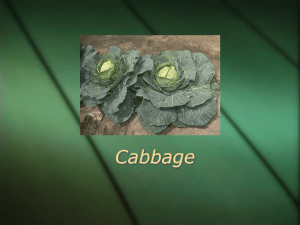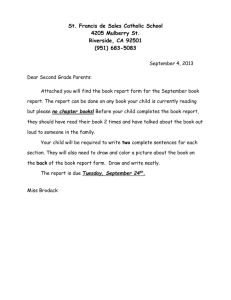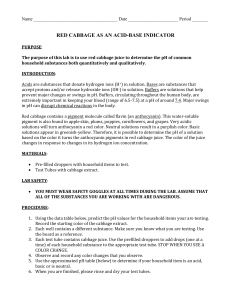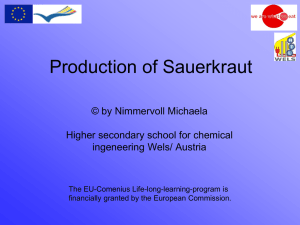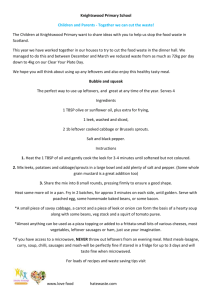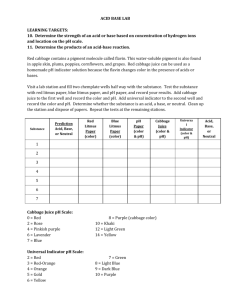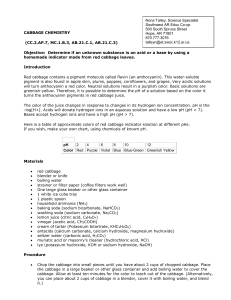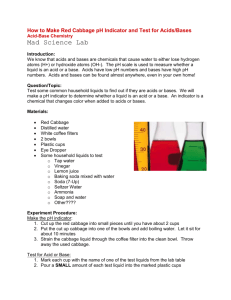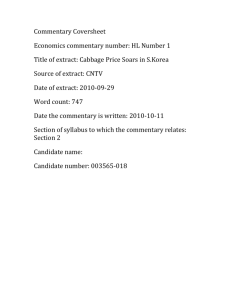Book Club Curriculum Project-2
advertisement
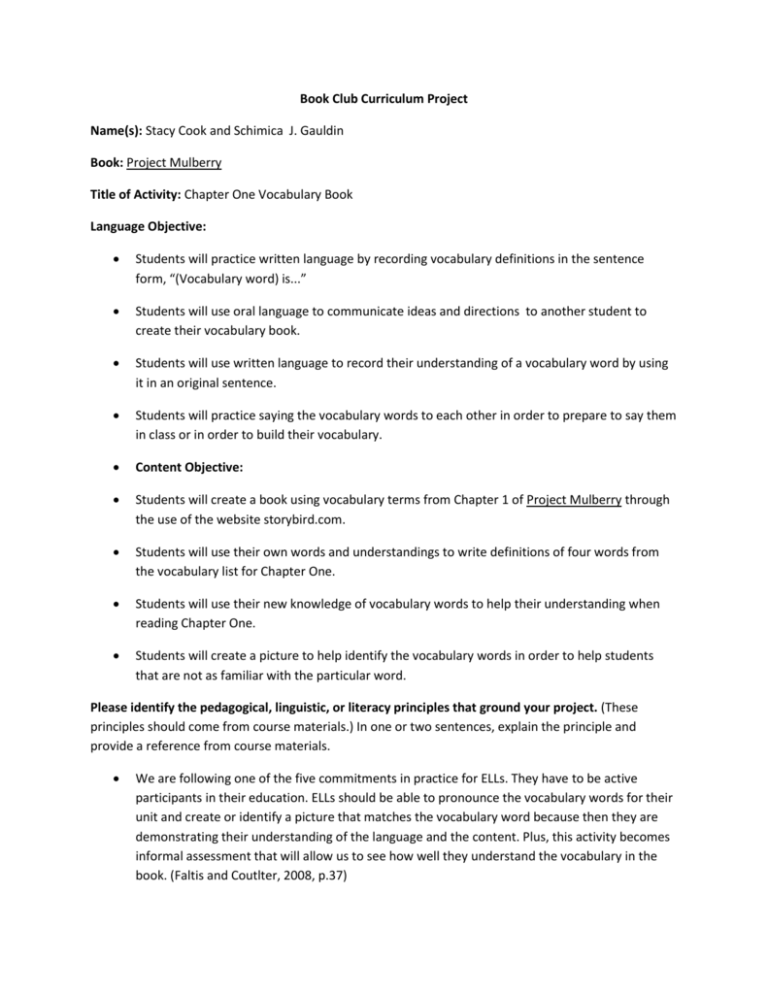
Book Club Curriculum Project Name(s): Stacy Cook and Schimica J. Gauldin Book: Project Mulberry Title of Activity: Chapter One Vocabulary Book Language Objective: Students will practice written language by recording vocabulary definitions in the sentence form, “(Vocabulary word) is...” Students will use oral language to communicate ideas and directions to another student to create their vocabulary book. Students will use written language to record their understanding of a vocabulary word by using it in an original sentence. Students will practice saying the vocabulary words to each other in order to prepare to say them in class or in order to build their vocabulary. Content Objective: Students will create a book using vocabulary terms from Chapter 1 of Project Mulberry through the use of the website storybird.com. Students will use their own words and understandings to write definitions of four words from the vocabulary list for Chapter One. Students will use their new knowledge of vocabulary words to help their understanding when reading Chapter One. Students will create a picture to help identify the vocabulary words in order to help students that are not as familiar with the particular word. Please identify the pedagogical, linguistic, or literacy principles that ground your project. (These principles should come from course materials.) In one or two sentences, explain the principle and provide a reference from course materials. We are following one of the five commitments in practice for ELLs. They have to be active participants in their education. ELLs should be able to pronounce the vocabulary words for their unit and create or identify a picture that matches the vocabulary word because then they are demonstrating their understanding of the language and the content. Plus, this activity becomes informal assessment that will allow us to see how well they understand the vocabulary in the book. (Faltis and Coutlter, 2008, p.37) By working in partnerships, students are working on many aspects of language (writing, listening, viewing, speaking). “When students are talking ot one another, they also have a chance to take turns listening to one another and thus to tie in several language abilities at once...The result is greater participation in multiple academic language uses, with students trying on new and varying identities as language users and academic learners” (Faltis, 2006, p. 97-98). Please describe in detail how you envision the activity to be carried out. You can write this as a bulleted list or in a paragraph. The goal is to make the directions sufficiently clear that a reader could imagine and carry out the activity. If it’s not obvious, also explain how your artifact fits in. Show students pictures of cucumbers. Ask students to share what types of foods cucumbers can be made into or different ways to eat cucumbers. After hearing ideas, share with students that cucumbers are also made into pickles, if it is not already stated by a student. Show students pictures of cabbage. Ask students to share what this food might be, how it can be eaten, and other foods that may be made from cabbage. After listening to student's ideas, share that cabbage is the leaf and stem part of the Brassica oleracea capitata plant. Cabbage can be eaten raw or cooked. Allow students to sample cabbage. Write the word kimchee on the board and ask students to brainstorm what they think this word means. Have students write a paragraph about a time when they ate pickles or cabbage. Remind them pickles are made into relish and relish is great on hot dogs. Give them a sentence stem if possible: I remember when I ate a hot dog with ketchup, mustard, and relish at the family cook out. Listen to students' ideas before sharing that cabbage can be made into a Korean dish called kimchee. Kimchee is made by adding many spices to cabbage. Many Korean people eat kimchee on a daily basis. Ask the students about other dishes that have cabbage in them. Spring rolls, egg rolls, and stuffed cabbage are popular dishes. (I don’t think if this helps or hurts) Transition into Project Mulberry by sharing that we are going to begin reading a book about a girl who is Korean and does not like to eat kimchee. Just like the word “kimchee” there are other words in this book that we do not know the meaning of. To help us prepare to read the book, students need to first learn and show they know the meaning of new vocabulary words that we will read in the first chapter of Project Mulberry. Present students with the attached list of vocabulary words. Ask if they have heard of any of these words before. If so, when and in what settings. Does thinking of these words bring back good or bad memories? Then have the students predict what the word means and why they think that, before sharing the actual definition for them to record in their own words. Show “Chapter One Vocabulary Book” made from storybird.com while explaining to students their assignment. With a partner, choose five vocabulary words to define, illustrate, and use in an original sentence in a vocabulary book. Use the model, “Chapter One Vocabulary Book” to demonstrate features of using the sentence structure, “(Vocabulary word)...” and other features that students should include based on the rubric. Allow students to work on their vocabulary books and collaborate on ideas, recording definitions, and using appropriate illustrations. When students are finished with their books, have them publish them on the website and look at other group's books to learn the meaning of other vocabulary words in the book. Afterwards, ask students to predict what might happen in the first chapter of Project Mulberry that uses these vocabulary words. Read the first chapter of Project Mulberry. Chapter One Vocabulary List for Project Mulberry Write in the definition for each of the following words. 1. reptile 2. community 3. kimchee 4. Korean 5. animal husbandry 6. wifery 7. DNA 8. gardening 9. exhibit 10. cabbage Multimedia Project : Project Mulberry Vocabulary Book CATEGORY Attractiveness 4 3 2 1 Makes excellent use of font, color, graphics, effects, etc. to enhance the presentation. Makes good use of font, color, graphics, effects, etc. to enhance to presentation. Makes use of font, color, graphics, effects, etc. but occasionally these detract from the presentation content. Use of font, color, graphics, effects etc. but these often distract from the presentaion content. Mechanics No misspellings or grammatical errors. Three or fewer misspellings and/or mechanical errors. Four misspellings and/or grammatical errors. More than 4 errors in spelling or grammar. Organization Content is well organized using headings or bulleted lists to group related material. Uses headings or bulleted lists to organize, but the overall organization of topics appears flawed. Content is logically organized for the most part. There was no clear or logical organizational structure, just lots of facts. Originality Product shows a large amount of original thought. Ideas are creative and inventive. Product shows some original thought. Work shows new ideas and insights. Uses other people's ideas (giving them credit), but there is little evidence of original thinking. Uses other people's ideas, but does not give them credit.

